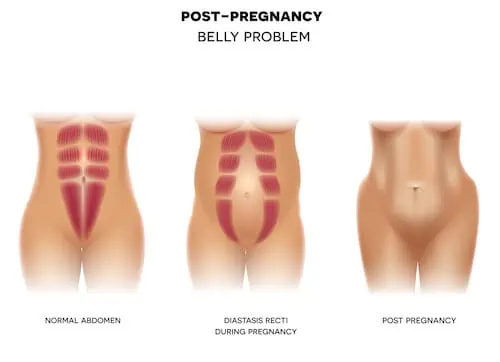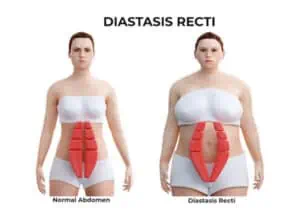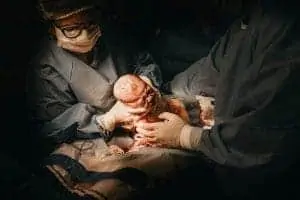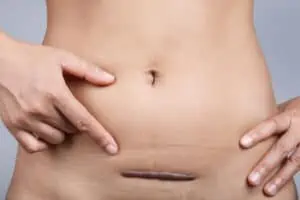Most women never hear about diastasis recti. Not until after they’ve given birth that is.
I was lucky. Friends of mine had warned me about it in advance, so I knew what to check for and what to ask my doctor.
But even if you’re years postpartum, the good news is you can correct diastasis recti. This post is all about your most pressing questions on the subject to get you off in the right direction.
What IS diastasis recti?
Essentially, this is when there is a space between the left and right sides of your abdominal muscles. Affectionately called the ‘belly pooch,’ your belly sticks out in this space.
While it is common for pregnant women (whether they’ve had a c-section or delivered vaginally), it can happen even for overweight people that never have any kids (like men, for example).

Roughly 2/3 of pregnant women have this condition. And the more kids you have, especially when they are closer in age to one another, the more likely you have to get it.
Another risk factor for diastasis recti is having kids over 35, having a big baby, or having multiples.
Most of the time, it will shrink back to size after birth, but it’s not always the case. And some women will develop it after giving birth. This belly overhang is why so many people seek answers for healing diastasis recti after a c-section.
You can do diastasis recti exercises after a c-section to get rid of belly overhang, but before you get busy, please read up on all these FAQs fellow mamas have about it so you can get rid of it with success!
How common is diastasis recti after c-section?
Nearly half of all women that give birth (45%) have diastasis recti at 6 months postpartum. As you can see, it’s quite common.
Surely, it’s not a club you want to be in, but you may not have a choice. The good news is that it can be fixed naturally. Surgery is also an option in extreme cases, but you should be able to heal things up all on your own.
Does a c-section make diastasis recti worse?
If you’re getting ready to have your first baby now and you’re going for a c-section, please don’t freak out thinking diastasis recti will automatically be worse because of it. You have a greater chance of having this happen with a c-section, but even those who deliver vaginally can get it.
Those with more than one pregnancy also have a greater risk no matter how they deliver. Experts theorize that this is because your body can stretch out and accommodate the pregnancy quicker.
It’s generally not painful though rare exceptions do occur. I don’t want you freaking out about that because you’ve got enough to worry about. I’ll say this…if anything is causing you major pain after you give birth, you should contact your doctor immediately.
How to check for diastasis recti after a c-section?
You may notice you have diastasis recti because your stomach bulges. It will be more noticeable as you contract your abdominal muscles too. You may feel lower back pain, be unable to maintain a proper posture, show bloating all the time, and deal with frequent constipation.
Even before you deliver, you may have this condition during pregnancy. After you give birth, that belly pooch would be the biggest clue. While it does take time for your body to shrink back down to size, as it does, your belly may make you look pregnant still, which is a good time to check and see if you have diastasis recti.
If you’re concerned about this, I recommend speaking to your doctor at your postpartum checkup and having them confirm. You can also check it yourself (though having a doctor confirm or deny its existence will help you all the more).
Here’s what you can do to see if you have diastasis recti:
- Lying on your back on the floor, keep your knees bent and your feet flat on the floor.
- Slightly raise your shoulders off the floor, ensuring you’re supporting your head with one of your hands while looking at your belly.
- With the other hand, move it above and below your belly button. You should move it all along that midline of the ab muscles. Can you fit any fingers in the gaps between the muscles?
If there is a gap of one or two finger lengths, you likely have diastasis recti. It will shrink more as your muscles get stronger again.
The doctor can check for this via ultrasound or caliper. So if you’re not sure as you perform this check, your doctor can be certain whether you have it or not.
Does diastasis recti heal on its own?
There is good news in that diastasis recti can heal on its own. Usually, this will happen about 6 months after you deliver. You can use the self-check steps I just mentioned above to monitor things.
If it seems like the gap is shrinking, that’s good. But if nothing changes or worsens, talk to your doctor about that.
How to fix diastasis recti after c-section?
Before you begin, I’d like you to talk to your doctor, just in case. We’re all different, and your doctor will best be able to assess your condition.
Gradually, you can do gentle movements and breath work right after vaginal births, but c-sections may need longer. Easing into it is the best way to do slow, intentional deep breathing exercises.
When you perform any functional movement, such as picking up your baby or standing up from a seated position, activate your core and exhale so that the transverse abdominals which wrap around your torso feel like a corset.
Once you get through your postpartum checkup, you can do dead bugs. This is when you lie on your back and bend your knees into a tabletop position. Then, slowly lower one heel to the ground and bring it back up. You’ll alternate sides and exhale to activate the deepest part of your core.
Pelvic tilts, heel slides, bridges with belly scooping, and abdominal compressions are great exercises too. The important thing is to avoid the usual exercises you’d have done before this for your abs. Those are listed a little further below.
The MUTU System is one I’ve heard great things about that can help you safely with diastasis recti without causing more damage. You can also try a workout like this one here. But again, before you try anything, please speak to your doctor!
Can you repair diastasis recti years later?
Some women never realize that their belly pooch is diastasis recti until years later. And that’s ok! You’re busy having kids and going crazy in a world with toddlers.
But it is NOT too late to correct diastasis recti even years later. And yes, you can do it without having surgery. It doesn’t matter how long ago you had your last baby.
How long does it take to heal diastasis recti with exercise?
When you start doing diastasis recti exercises, you should do them 3 to 4 times per week. Within about 6 to 8 weeks, you should start seeing improvements.
However, if nothing changes, you should ask your doctor for a referral to a physical therapist. They can help you get things back on track. Make sure the physical therapist you choose has not only experience in healing diastasis recti but also has good reviews.

And, of course, you want to ensure you’re not doing anything that could worsen diastasis recti. Certain exercises should not be done until it has healed. So, with diastasis recti, avoid these exercises:
- Planks
- Crunches
- Ab twists
- Backward bends
- Heavy lifting
When to start diastasis recti exercises after c-section?
Just like with any exercise after a c-section, except for light walking, you should wait until you’ve had your postpartum checkup. This will be around 6 to 8 weeks postpartum.
When your doctor says everything is healing well, you can begin these exercises and do more strenuous workouts. While you’re there, have your doctor check for diastasis recti. It may have already started healing in the time since you gave birth to this latest checkup. Doing so will help you figure out the best exercises to help close the rest of the gap and eliminate belly overhang.
Can you fully recover diastasis recti after giving birth?
I don’t want to get your hopes up, but you may find that if you had diastasis recti during pregnancy, it might correct itself on its own after delivery. However, it will take a few weeks to months of doing those exercises at home to help recover from it for many other women.
If nothing has changed 8 weeks after your baby is born, you can consult your doctor even with exercise. Ask for a reference from a physical therapist or a fitness specialist who has worked with postpartum body care.
Does diastasis recti have long-term effects on other parts of the body?
Sometimes, diastasis recti can affect other parts of the body. It could weaken your abdominal organs, cause stress urinary incontinence, and leave you with lower back pain or pelvic organ prolapse, where the organs come down.
This is not all that common, so please try not to stress. Your doctor will check for this at your postpartum checkup, and if this problem arises, it will be taken care of.
Can massage help diastasis recti?
Yes, you can do massage therapy for diastasis recti. However, I do not think you should just wing it. You should seek a physical therapist specializing in helping with diastasis recti. Someone that does not have this experience could wind up making things worse.
One last thing about diastasis recti…
You know yourself best, so if something hurts, if you notice anything unusual in the abdominal area, or if you don’t feel like yourself weeks after giving birth, don’t hesitate to get in touch with your doctor. They will be able to help you get back to looking and feeling like yourself so you can enjoy being a mom to the fullest!
Leslie Berry lives with her husband and two young daughters in Los Altos, California, where she loves helping other moms get comfortable with motherhood and embracing the insanity with facts peppered with laughs.
She loves eating too much sushi, exercising, and jamming out on her Fender. Read more about Leslie here.






